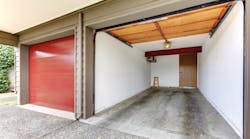All references are based on the 2017 edition of the NEC.
Section 210.52(G)(1) was revised for the 2017 Code to help clarify acceptable locations for the required receptacles in garages of one- and two-family dwellings. It spells out very clearly that for each attached garage, and each detached garage with electric power, at least one receptacle outlet must be installed in each vehicle bay and not more 5½ ft above the floor. This revision means that receptacle outlets installed high on the walls, or on the ceiling for powering electric garage door openers will not be considered the “required” receptacles. What is not clarified is the circuit size needed to supply the required receptacles. Does it need to be a 20A circuit or can it be a 15A circuit?
Well, Sec. 210.11(C)(4) was added in this latest edition of the Code, and it may help answer that question. It states, “In addition to the number of branch circuits required by other parts of this Section, at least one 120V, 20A branch circuit shall be installed to supply receptacle outlets in attached garages and in detached garages with electric power. This circuit shall have no other outlets.” So it seems as though the receptacles required by Sec. 210.52(G) must be supplied by this 20A circuit. That is not necessarily the case, however.
Perhaps an installer could use a 20A circuit to supply some receptacles installed on the ceiling for powering the garage door openers. This 20A circuit would not have any other outlets except readily accessible outdoor receptacles. This arrangement would fulfill the literal requirements of Sec. 210.11(C)(4). A 15A circuit could then be used to supply the receptacles required by Sec. 210.52(G)(1). This 15A circuit could also be used to supply lighting outlets and receptacle outlets inside and outside of the garage and elsewhere on the property. But is the intent of Sec. 210.11(C)(4) to require the 20A circuit to supply power to the receptacles required by 210.52(G)?
The Public Inputs submitted during the last revision cycle seem to indicate this was, in fact, the intent. Should it be? You might need to have a professional and productive discussion with your AHJ about what circuit arrangements are acceptable in your area





